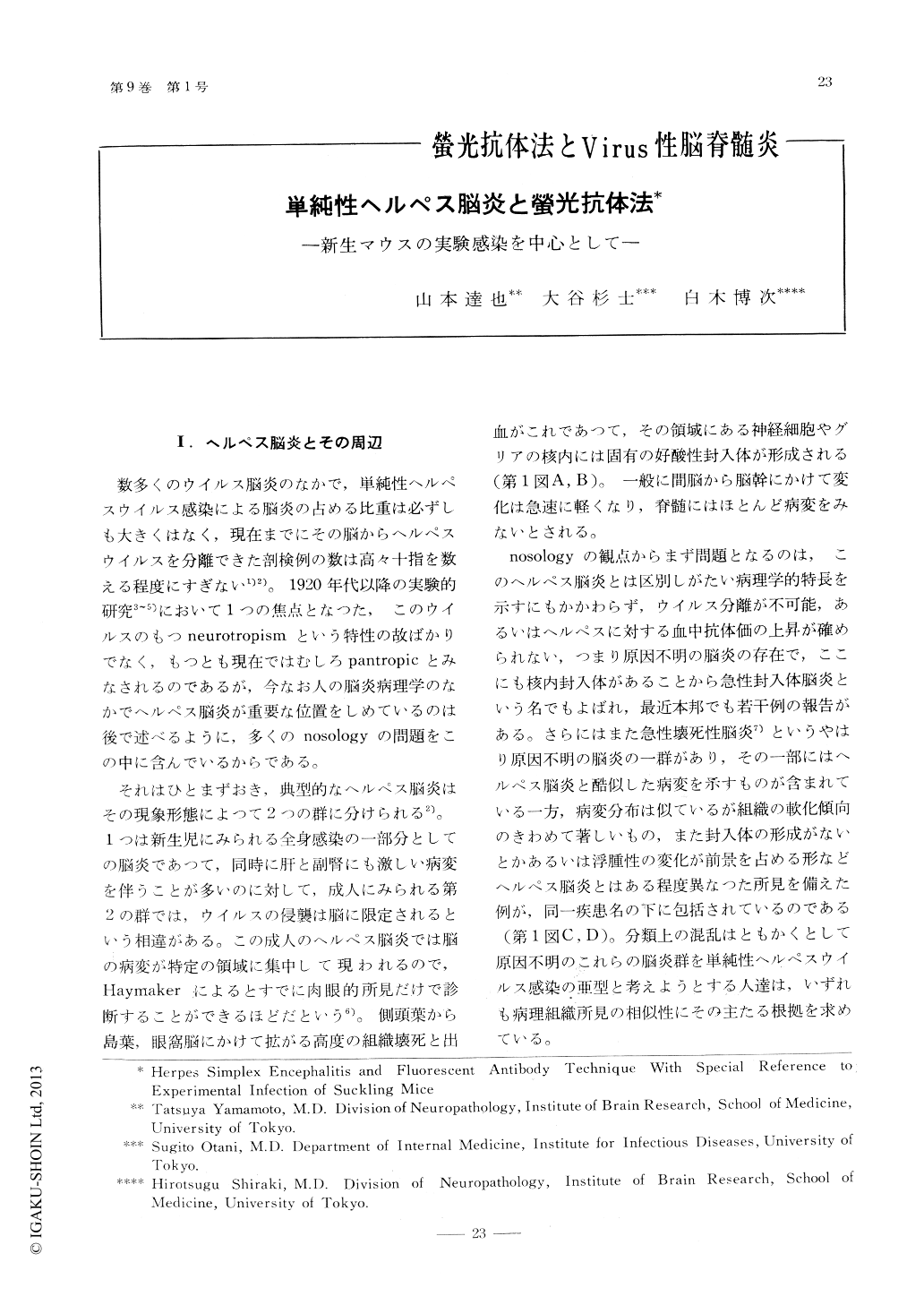Japanese
English
- 有料閲覧
- Abstract 文献概要
- 1ページ目 Look Inside
I.ヘルペス脳炎とその周辺
数多くのウイルス脳炎のなかで,単純性ヘルペスウイルス感染による脳炎の占める比重は必ずしも大きくはなく,現在までにその脳からヘルペスウイルスを分離できた剖検例の数は高々十指を数える程度にすぎない1)2)。1920年代以降の実験的研究3〜5)において1つの焦点となつた,このウイルスのもつneurotropismという特性の故ばかりでなく,もつとも現在ではむしろpantropicとみなされるのであるが,今なお人の脳炎病理学のなかでヘルペス脳炎が重要な位置をしめているのは後で述べるように,多くのnosologyの問題をこの中に含んでいるからである。
それはひとまずおき,典型的なヘルペス脳炎はその現象形態によつて2つの群に分けられる2)。1つは新生児にみられる全身感染の一部分としての脳炎であつて,同時に肝と副腎にも激しい病変を伴うことが多いのに対して,成人にみられる第2の群では,ウイルスの侵襲は脳に限定されるという相違がある。この成人のヘルペス脳炎では脳の病変が特定の領域に集中して現われるので,Haymakerによるとすでに肉眼的所見だけで診断することができるほどだという6)。側頭葉から島葉,眼窩脳にかけて拡がる高度の組織壊死と出血がこれであつて,その領域にある神経細胞やグリアの核内には固有の好酸性封入体が形成される(第1図A,B)。
The histopathology of herpes simplex encephalitis have offered a clue as to the pathogenesis of viral encephalitis in general. On the other hand, herpes simplex or allied viruses were suspected as causative agents in a group of encephalitides of unknown etiology such as acute necrotising encephalitis, subacute inclusion encephalitis and sub-acute sclerosing leucoencephalitis. It is evident that the final solution of these etiopathogenetic problems can not he achieved by a simple comparison of their pathomorphological features, but depends on a full knowledge of the mechanisms regulating the development of infection as well as the success of virus isolation.
The present experiment was attempted to investigate the pattern of virus propagation of herpetic infection using the fluorescent antibody technique. The results obtained in suckling mice inoculated intrapertioneally with herpes simplex virus are summarized as follows (Figs. 1-7). 1) An involvement of the nervous-. system occurred independent of the infection of viscera such as the gastrointestinal tracts, liver, lung, etc. 2) The pathways of virus inoculated to the central nervous system, consisted of two routes, i.e. hematogenous and neural. The former way was responsible for the infection of the cerebrum, diencephalon and cerebellum, the latter, for that of the spinal cord and sympathetic ganglia. The brain stem lesions seemed to be produced by both ways. 3) Host cells in herpetic infection comprized nerve cells and astrocytes in the central nervous system, and Schwann cells in peripheral nerves. Viral antigen demonstrated by fluorescent antibody staining was exclusively localized within the cytoplasm of infected cells. Consequently, it, is emphasized that the fluorescent antibody technique is a promising one for the pathogenetic study of viral encephalitides.

Copyright © 1965, Igaku-Shoin Ltd. All rights reserved.


